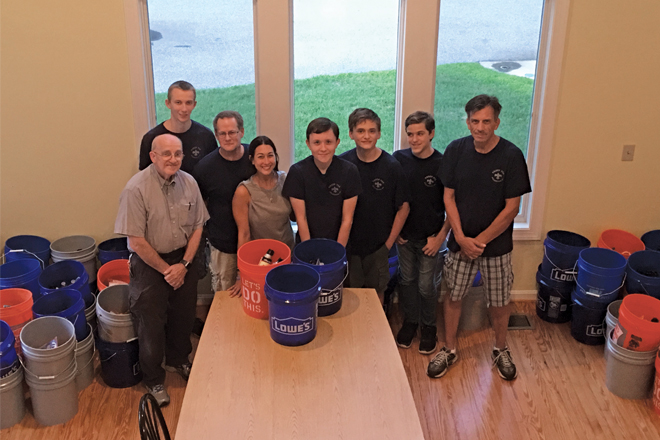Photo above: Staff and students at Indian Creek School assemble "go buckets" for every classroom and other vulnerable areas with emergency supplies.
Article by Diana Ortiz, Indian Creek School
"Won’t learning these skills just scare our children?"
Last year Indian Creek School began replacing traditional lockdown drills with a proactive, options-based response to potential active shooter events. That meant teaching students skills such as barricading a room to block an intruder or evacuating when appropriate. Our leaders faced many questions like the one above. Would the new protocols make students feel any safer?

I knew something had to change after participating in a traditional lockdown drill, colloquially known as “stay and pray.” Curling up in a ball in a dark corner made me realize how helpless, demoralized and afraid our children and adults had been feeling through our previous protocol. Virtually all of our adults and children voiced the same feelings.
We adopted a program from ALICE Training Institute (ALICE stands for Alert-Lockdown-Inform-Counter-Evacuate). It’s made a world of difference in how our students, faculty and staff feel about active shooter threats, and the options-based skills complement our current educational focus on critical thinking, leadership, teamwork and grit.
Here’s how we built confidence, trust and strength in our community.
An Implementation Guide
1. Engage Local Law Enforcement
The federal government now recommends dynamic responses to active shooter events, not static lockdown. Years prior, our local agencies encouraged static lockdown only. Now we match our procedures with local law enforcement’s capabilities, as mandated by law.
Inviting officers to school events, allowing them to host events on campus for free, and inviting them to stop in anytime for coffee or a break has helped students feel less concerned when they see “cops on campus.” It has also familiarized police and fire departments with our two campuses, should an event ever occur.
2. Research Programs and Learn from Nearby Schools
“Run, Hide, Fight,” “CRASE” (Civilian Response to Active Shooter Events) and “Avoid, Deny, Defend” are other notable options-based programs. Indian Creek chose ALICE primarily for its strong K-12 program, affordable and interesting online course module, and reputation as an industry leader. Furthermore, many regional schools also use ALICE, and we have welcomed the opportunity to share experiences and resources.
3. Engage Key Stakeholders — and Naysayers
In spring 2017, we sent five representatives to a two-day ALICE training to become certified instructors. We selected leaders from our upper school, lower school and early childhood program. Sending representatives from different departments generated commitment, buy-in and credibility for the program throughout the school.
Giving faculty and staff choices during an emergency procedure was unchartered territory for us, as many people find comfort in a more directive environment. However, as they trained and felt their own empowerment, they quickly saw the value in adopting a dynamic response.
4. Engage Faculty and Staff
We told faculty and staff about the coming change in early fall 2017. Then we phased in online training, active scenario drills and tabletop drills. Employees weighed in on the content and pace of student learning and communications with parents. We discussed what age levels should be taught which skills and how we should actively practice the skills students learned.

5. Engage Parents
We explained the plan to parents through a series of weekly newsletter articles, focusing first on safety as a broad topic, followed by a deeper dive into what ALICE is and why we chose it. Later, we held a parent information night for each division, timed shortly after a professional development day on ALICE and as we were first introducing content to students. We offered parents the same training opportunities as staff, including the online course and active-scenario drills training. Parents showed gratitude and interest in learning the skills.
6. Engage Students
We assured students that changing our protocol did not indicate any increased threat to them, and that our community is as safe as it has always been. We emphasized that the skills they learned are transferrable outside of school. We encouraged them to submit questions anonymously, and gave teachers a guide to help them answer common questions with confidence and consistency.
Since implementation, we’ve used our active-shooter protocol change as an opportunity to create dialogue surrounding all our emergency preparedness drills. Reflecting and collecting feedback is an important part of our process moving forward.
A Stronger Community
ALICE requires that at least 75 percent of faculty and staff be certified for the school to receive its organizational certification. A full 92 percent of Indian Creek faculty and staff are now ALICE-certified, in addition to more than 30 parents. We believe the more members of our community are trained, the stronger we will be.
This past spring, a faculty member who is also a parent told me how her anxious young son experienced the ALICE training. On a drive home from school one day, without any prompt, he talked about all the ALICE skills he learned — and he remembered everything. He explained that he learned he had options and could make his own decisions if he ever needed to. She could tell he was not afraid or anxious. He felt empowered.





